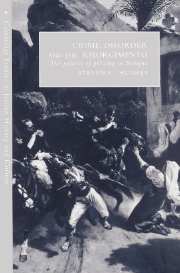Book contents
- Frontmatter
- Contents
- List of illustrations and tables
- Acknowledgments
- List of abbreviations and note on footnotes
- Map 1 Primary political divisions of the Papal States in 1842
- Map 2 Legation of Bologna 1821
- Introduction
- 1 Setting the stage: Bologna, the ancien régime, and Napoleon
- 2 Consalvi's cops
- 3 Functions and failures (1815–1831)
- 4 Public order and the revolution of 1831
- 5 Reform and failure (1832–1847)
- 6 Reform and revolution (1847–1849)
- 7 The search for stability and the turn to Piedmont (1849–1859)
- 8 Epilogue: Risorgimento, freedom, and repression
- 9 Conclusion
- Appendix A Personnel plans of Bologna's Provincial Police, 1816–1863
- Appendix B The pattern of crime in Bologna, 1819–1846
- Index
4 - Public order and the revolution of 1831
Published online by Cambridge University Press: 06 July 2010
- Frontmatter
- Contents
- List of illustrations and tables
- Acknowledgments
- List of abbreviations and note on footnotes
- Map 1 Primary political divisions of the Papal States in 1842
- Map 2 Legation of Bologna 1821
- Introduction
- 1 Setting the stage: Bologna, the ancien régime, and Napoleon
- 2 Consalvi's cops
- 3 Functions and failures (1815–1831)
- 4 Public order and the revolution of 1831
- 5 Reform and failure (1832–1847)
- 6 Reform and revolution (1847–1849)
- 7 The search for stability and the turn to Piedmont (1849–1859)
- 8 Epilogue: Risorgimento, freedom, and repression
- 9 Conclusion
- Appendix A Personnel plans of Bologna's Provincial Police, 1816–1863
- Appendix B The pattern of crime in Bologna, 1819–1846
- Index
Summary
The year 1831 was full of hopes and full of fears. Understandably, historical interest has focused on the hopes; for the popular assemblies and political aspirations of the revolution of 1831 figure heavily in the traditions of Italian nationalism. Yet to ignore the fears and the very real conditions that inspired them is to miss the complexity of the moment and to obscure the dynamics of the movement. Likewise, without understanding the social trepidation that underlay the revolution, the apparent paradoxes of the papal restoration become unintelligible. Why else would the papal regime rearm the rebels of Bologna only five months after defeating them? Why else would Austrian troops be greeted in 1832 as the saviors of the city? At every turn, in a year full of turns, the specter of crime, riot, and looting hung heavily over the province, shaping the political and tactical decisions of each group coming to power. Avoiding anarchy was the prime mover, the basic consideration that permeated the political process before, during, and after the revolution. All other objectives, goals, and programs had to be placed within that framework. Consequently, the police and public force held center stage for much of the time, acting and reacting to the changes wrought by different ideologies and authorities. With the revolution and its aftermath, the confusion of criminality, conspiracy, and politics that had marked the late 1820s entered a new phase, as opposition to the Pope's regime became manifest and fashionable, setting the wretched precettato and the fancy politico on the same side of the legal fence.
- Type
- Chapter
- Information
- Crime, Disorder, and the RisorgimentoThe Politics of Policing in Bologna, pp. 107 - 135Publisher: Cambridge University PressPrint publication year: 1994



